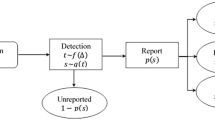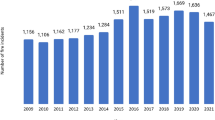Abstract
The objectives of this study are to estimate smoke alarm coverage and adherence with national guidelines in low- to mid-value owner-occupied residences, and to identify resident demographic, behavioral, and building characteristics and other fire and burn safety practices associated with smoke alarm utilization. Baseline visits were conducted with 779 households in King County, Washington, for a randomized trial of smoke alarm functionality. Presence, functionality, features, and location of pre-existing smoke alarms were ascertained by staff observation and testing. Household and building descriptors were collected using questionnaires. Households were classified by presence of smoke alarms, functional alarms, and functional and properly mounted alarms placed in hallways and on each floor but not in recommended avoidance locations. Smoke alarms were present in 89%, and functional units in 78%, of households. Only 6–38% met all assessed functionality and placement recommendations. Homes frequently lacked alarms in any bedrooms or on each floor. Building age, but not renovation status, was associated with all dimensions of smoke alarm coverage; post-1980 constructions were 1.7 times more likely to comply with placement recommendations than were pre-1941 homes (95% CI: 1.1–2.6). Respondent education and race/ethnicity, children <5 years, residency duration, number of floors, wood stoves and fireplaces, number of smoke alarms, recency of smoke alarm testing, carbon monoxide monitors, and fire ladders displayed varying relationships with alarm presence, functionality, and placement. Strategies for maintaining smoke alarms in functional condition and improving compliance with placement recommendations are necessary to achieve universal coverage, and will benefit the majority of households.
Similar content being viewed by others
References
Ahrens, M. (2007). U.S. experience with smoke alarms and other fire detection/alarm equipment. Quincy, MA: National Fire Protection Association, Fire Analysis and Research Division.
McLoughlin, E., Marchone, M., Hanger, L., German, P. S., & Baker, S. P. (1985). Smoke detector legislation: Its effect on owner-occupied homes. American Journal of Public Health, 75, 858–862.
National Fire Data Center, U.S. Fire Administration. (2007). Fire in the United States 1995–2004 (14 ed.). Emmitsburg, MD: Federal Emergency Management Agency, U.S. Fire Administration. Report FA-311.
National Fire Data Center, U.S. Fire Administration. (2004). Fire in the United States 1992–2001 (13 ed.). Emmitsburg, MD: Federal Emergency Management Agency, U.S. Fire Administration. Report FA-286.
Smith, L. E. (1995). Fire incident study—national smoke detector project. Bethesda, MD: U.S. Consumer Product Safety Commission, Directorate for Epidemiology.
Istre, G. R., McCoy, M. A., Osborn, L., Barnard, J. J., & Bolton, A. (2001). Deaths and injuries from house fires. New England Journal of Medicine, 344, 1911–1916.
Marshall, S. W., Runyan, C. W., Bangdiwala, S. I., Linzer, M. A., Sacks, J. J., & Butts, J. D. (1998). Fatal residential fires: Who dies and who survives? JAMA, 279, 1633–1637.
Runyan, C. W., Bandiwala, S. I., Linzer, M. A., Sacks, J. J., & Butts, J. (1992). Risk factors for fatal residential fires. New England Journal of Medicine, 327, 859–863.
Smith, C. L. (1994). Smoke detector operability survey: Report on findings (revised). Bethesda, MD: Consumer Product Safety Commission, Directorate for Economic Analysis.
Berger, L. R., & Kuklinski, D. M. (2001). When smoke alarms are a nuisance: A call to action. Archives of Pediatrics and Adolescent Medicine, 155, 875–876.
NFPA 72—National Fire Alarm Code. Quincy, MA: National Fire Protection Association, 2007.
2006 Seattle Residential Code: International Residential Code for one- and two-family dwellings, as amended by the city of Seattle. Country Club Hills, IL and Seattle, WA: International Code Council, Inc. and City of Seattle, 2007. http://www2.iccsafe.org/states/Seattle2006/seattle_residential/res_frameset.htm. Accessed 19 Jan 2010.
Harris Interactive. Fire Prevention Week Survey. Quincy, MA: National Fire Protection Association, Public Affairs Division, 2004. http://www.nfpa.org/assets/images/Public%20Education/FPWsurvey.pdf. Accessed 20 Jan 2010.
Peek-Asa, C., Allareddy, V., Yang, J., Taylor, C., Lundell, J., & Zwerling, C. (2005). When one is not enough: Prevalence and characteristics of homes not adequately protected by smoke alarms. Injury Prevention, 11, 364–368.
Ballesteros, M. F., & Kresnow, M. J. (2007). Prevalence of residential smoke alarms and fire escape plans in the U.S.: Results from the Second Injury Control and Risk Survey (ICARIS-2). Public Health Reports, 122, 224–231.
Runyan, C. W., Johnson, R. M., Yang, J., et al. (2005). Risk and protective factors for fires, burns, and carbon monoxide poisoning in U.S. households. American Journal of Preventive Medicine, 28, 102–108.
Harvey, P. A., Sacks, J. J., Ryan, G. W., & Bender, P. F. (1998). Residential smoke alarms and fire escape plans. Public Health Reports, 113, 459–464.
Furjuoh, S. N., Coben, J. H., Dearwater, S. R., & Weiss, H. B. (1997). Identifying homes with inadequate smoke detector protection from residential fires in Pennsylvania. Journal of Burn Care and Rehabilitation, 18, 86–91.
Hoffman, R. E. (1986). Tracking 1990 objectives for injury prevention with 1985 NHIS findings. Public Health Reports, 101, 581–586.
McKnight, R. H., Struttmann, T. W., & Mays, J. R. (1995). Finding homes without smoke detectors: One step in planning burn prevention programs. Journal of Burn Care and Rehabilitation, 16, 548–556.
Mueller, B. A., Sidman, E. A., Alter, H., Perkins, R., & Grossman, D. C. (2008). Randomized controlled trial of ionization and photoelectric smoke alarm functionality. Injury Prevention, 14, 80–86.
Zou, G. (2004). A modified Poisson regression approach to prospective studies with binary data. American Journal of Epidemiology, 159, 702–706.
Bolen, J. C., Sacks, J. J., & Bland, S. D. (1999). Injury prevention behaviors: A report card for the nation, 1995. Preventive Medicine, 29, 195–201.
Piani, A. L., & Schoenborn, C. A. (1993). Health promotion and disease prevention: United States, 1990. Vital and Health Statistics, 10, 1–88.
Portugill, J., Powell, P. (Eds.) (1977). Smoke detector resource catalog. Washington, DC: National Fire Prevention and Control Administration. Report CE 017 146.
National Fire Prevention and Control Administration. (1977). Smoke detectors and legislation. Washington, DC: National Fire Prevention and Control Administration. Report CE 017 147.
Stone, K. E., Eastman, E. M., Gielen, A. C., et al. (2007). Home safety in inner cities: Prevalence and feasibility of home safety-product use in inner-city housing. Pediatrics, 120, e346–e353.
Smoke detection devices in dwelling units—penalty, RCW 43.44.110 (1980, last modified 2005), Washington State Legislature. http://apps.leg.wa.gov/rcw/default.aspx?cite=43.44.110. Accessed 20 Jan 2010.
Smoke detection devices in dwelling units, Chapter 212-10 WAC (1981). Washington State Legislature. http://apps.leg.wa.gov/WAC/default.aspx?cite=212-10&full=true. Accessed 20 Jan 2010.
State building code—adoption—conflicts—opinions, RCW 19.27.031 (2003). Washington State Legislature. http://apps.leg.wa.gov/RCW/default.aspx?cite=19.27.031. Accessed 20 Jan 2010.
Shaw, K. N., McCormick, M. C., Kustra, S. L., Ruddy, R. M., & Casey, R. D. (1988). Correlates of reported smoke detector usage in an inner-city population: Participants in a smoke detector give-away program. American Journal of Public Health, 78, 650–653.
Pennsylvania Department of Health. (2002). 2002 behavioral health risk of Pennsylvania adults—smoke detectors (pp. 30–31). Harrisburg, PA: Pennsylvania Department of Health. http://www.dsf.health.state.pa.us/health/lib/health/BRFSS/PA2002/SmkDtBRFSS2002.pdf. Accessed 20 Jan 2010.
Douglas, M. R., Mallonee, S., & Istre, G. R. (1999). Estimating the proportion of homes with functioning smoke alarms: A comparison of telephone survey and household survey results. American Journal of Public Health, 89, 1112–1114.
U.S. Fire Administration. (2009). USFA fire prevention and safety campaigns (last reviewed December 2009). Emmitsburg, MD: Federal Emergency Management Agency, U.S. Fire Administration. http://www.usfa.dhs.gov/campaigns/. Accessed 20 Jan 2010.
Directgov. (2010). Fire kills. London, UK: Directgov, UK Department for Work and Pensions. http://firekills.direct.gov.uk/index.html. Accessed 12 July 2010.
Acknowledgments
We wish to acknowledge the King County Fire Chiefs’ Association for their support, Mr. Chris Mack for data management assistance, and Dr. Harrison Alter for instigating the original randomized controlled trial which provided these data. We are also indebted to Ms. Luann D’Ambrosio and Ms. Milda Tautvydas for their organizational efforts. This work was supported in part by grant no. R49/CCR002570 from the Centers for Disease Control and Prevention (CDC).
Author information
Authors and Affiliations
Corresponding author
Rights and permissions
About this article
Cite this article
Sidman, E.A., Grossman, D.C. & Mueller, B.A. Comprehensive Smoke Alarm Coverage in Lower Economic Status Homes: Alarm Presence, Functionality, and Placement. J Community Health 36, 525–533 (2011). https://doi.org/10.1007/s10900-010-9337-3
Published:
Issue Date:
DOI: https://doi.org/10.1007/s10900-010-9337-3




